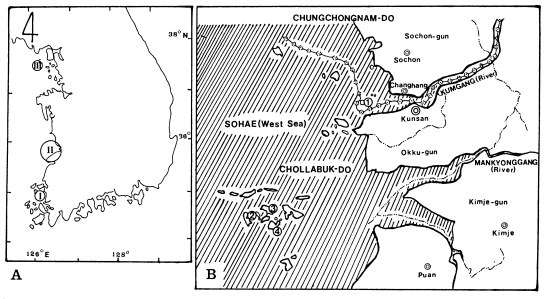Cited By
Citations to this article as recorded by

Food-borne intestinal trematode infections in the Republic of Korea
Jong-Yil Chai, Soon-Hyung Lee
Parasitology International.2002; 51(2): 129.
CrossRef Gymnophalloides seoi: a new human intestinal trematode
Jong-Yil Chai, Min-Ho Choi, Jae-Ran Yu, Soon-Hyung Lee
Trends in Parasitology.2003; 19(3): 109.
CrossRef A nationwide survey of the prevalence of human Gymnophalloides seoi infection on western and southern coastal islands in the Republic of Korea
Jong-Yil Chai, Jae-Hwan Park, Eun-Taek Han, Eun-Hee Shin, Jae-Lip Kim, Kwang-Seon Hong, Han-Jong Rim, Soon-Hyung Lee
The Korean Journal of Parasitology.2001; 39(1): 23.
CrossRef Intestinal histopathology and in situ postures of Gymnophalloides seoi in experimentally infected mice
Jong-Yil Chai, Hong-Soon Lee, Sung-Jong Hong, Jae Hyung Yoo, Sang-Mee Guk, Min Seo, Min-Ho Choi, Soon-Hyung Lee
The Korean Journal of Parasitology.2001; 39(1): 31.
CrossRef A review of Gymnophalloides seoi (Digenea: Gymnophallidae) and human infections in the Republic of Korea
Soon-Hyung Lee, Jong-Yil Chai
The Korean Journal of Parasitology.2001; 39(2): 85.
CrossRef A new endemic focus of Gymnophalloides seoi infection on Aphae Island, Shinan-gun, Jeollanam-do
Jae-Hwan Park, Sang-Mee Guk, Eun-Hee Shin, Hyo-Jin Kim, Jae-Lip Kim, Min Seo, Yun-Kyu Park, Jong-Yil Chai
The Korean Journal of Parasitology.2007; 45(1): 39.
CrossRef Foodborne Intestinal Flukes in Southeast Asia
Jong-Yil Chai, Eun-Hee Shin, Soon-Hyung Lee, Han-Jong Rim
The Korean Journal of Parasitology.2009; 47(Suppl): S69.
CrossRef Prevalence and Density of Digenetic Trematode Metacercariae in Clams and Oysters from Western Coastal Regions of the Republic of Korea
Woon-Mok Sohn, Byoung-Kuk Na, Shin-Hyeong Cho, Won-Ja Lee
The Korean Journal of Parasitology.2017; 55(4): 399.
CrossRef Survey of Gymnophalloides seoi Metacercariae in Natural and Cultured Oysters from Several Western Coastal Areas, Korea
Taehee Chang, Bong-Kwang Jung, Hyemi Song, Jaeeun Cho, Sooji Hong, Keon-Hoon Lee, Eui-Hyug Hoang, Jisu Kang, Jini Lim, Hana Lee, Jong-Yil Chai
The Korean Journal of Parasitology.2019; 57(6): 705.
CrossRef
Abstract
An epidemiological survey was performed to know the infection status of oysters with Gymnophalloides seoi metacercariae in 7 islands of the West Sea known as the habitat of paleartic oystercatchers, Haematopus ostralegus osculans, in Korea. The surveyed areas were Aphaedo (Shinan-gun, Chollanam-do), Jangjado, Sonyudo and Munyodo (Okdo-myon, Kunsan-shi, Chollabuk-do), Yubudo (Changhang-up, Sochon-gun Chungchongnam-do), and Polumdo and Chumoondo (Sodo-myon, Kangwha-gun. Inchon-shi). The oysters collected from Aphaedo, the known endemic focus, were examined monthly from August 1995 to October 1996 for observation of any seasonal variation of the metacercarial density. The average metacercarial burden was 761-2,077 by month, but the seasonal variation of the metacercarial density was not obvious. A total of 54 metacercariae was detected in 63 oysters collected from Yubudo. Out of 30 oysters from Sonyudo, 25 (83.3%) were infected with 1-66 metacercariae (12.6 in average). All of 50 oysters (100%) from Munyodo were infected with 3-162 metacercariae (53.5 in average). Only 4 metacercariae were detected in 100 oysters from Chumoondo. However, no metacercariae were found in 55 oysters from Jangjado and 50 oysters from Polumdo. From the above results, it was confirmed that G. seoi is still highly prevalent in oysters from Aphaedo, and several islands of the West Sea known as the habitats of paleartic oystercatchers are new endemic areas of this fluke.
Key words: Gymnophalloides seoi, metacercariae, oyster, paleartic oystercatcher, Haematopus ostralegus osculans, Aphaedo, Sonyudo, Munyodo, Yubudo, Chumoondo



